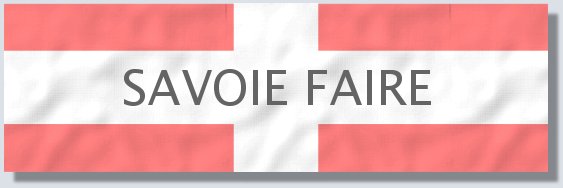|
After a moderately successful stint
in Provence,
I find myself returning to France for another extended stay.
This time I’m stationed in the mountainous Savoie region
in the southeast. Despite stinging criticism of my first
attempt at a blog, I have decided to continue the tradition
more for my own benefit than for anyone else’s. Putting
together a short record of my stay prompts me to get out
and about the region, forces me to find out more information
about the places I visit, and above all, provides me with
a souvenir of which I can remember fondly for years to come.
Still, my last blog turned out to be a lot more work than
I expected; therefore, I’ve decided to update the content
monthly rather than weekly. I'm also taking my wife's advice
- more pictures, less words. Other than that, the format
remains relatively unchanged.
So let’s get started…
|
|
|
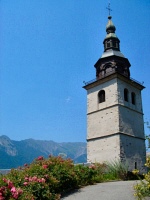
Summer in the Savoie.
|
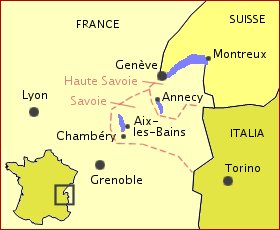
|
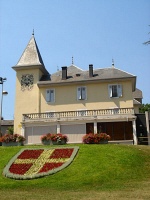
Typical Savoie architecture.
|
|
|
Chances are you’ve never heard of
the Savoie, which is known to the English-speaking world
as Savoy. To be perfectly honest, neither did I. But it
would be negligent to not find out at least something in
advance about where I was going, so I’ll share what little
I know. Of course, I knew about the more famous parts of
the region such as Mont Blanc, Chamonix, Grenoble, and Lake
Geneva, but as I found out, there is much more to the area.
Today, Savoie refers to one of the
hundred or so départements that make up France.
Adjoining it to the north is the Haute-Savoie (High Savoie)
which the areas along Lake Geneva (see my nifty map above).
To the east, both départements are bordered
by the Alps, along which runs the French-Italian frontier.
Lake Geneva constitutes the border with Switzerland. However,
prior to its annexation by France in 1860, the Savoie was
a sovereign state that included western Switzerland, the
Piedmonte region of Italy (the westernmost part of Italy
around Turin), and extended westward almost to Lyon and
as far south as Nice. It encompassed almost all of the western
Alps, making it a strategic, and therefore desirable, region
throughout its history.
The history of the Savoie is somewhat
complicated, but I’ll give you the 50 cent version here
for the sake of brevity. As usual, we’ll start with the
Romans who made their way into the area in the 1st century
BC. Encountering moderate resistance from the Gallic tribes
of the area, most notably the Allobroges, the Romans built
founded some towns, established major roads, and increased
the agricultural productivity of the area. The post-Roman
era saw the Savoie have strong influences from the Kingdom
of Burgundy to the north, and it was eventually included
as part of Lotharingia after the breakup of Charlemagne’s
kingdom. The House of Savioe was established by the last
Burgundian king, Rudolph III and maintained its independence
under Humbert White-Hands after the Savoie officially became
territory of the German Emporer, Konrad II. The Counts of
Savoie flourished in the Middle Ages by controlling trade
across the Alps, and established a capital at Chambéry
along the old Roman road between Grenoble and Geneva. By
creating a senate at Chambéry, investing tax money
back into the maintenance of the state, and giving political
and judicial power to local magistrates throughout the Savoie,
the Counts of Savoie created a recipe for government that
allowed the region to succeed as a sovereign state for nearly
a millennium. The Counts of Savoie eventually became dukes
and finally kings, once Sardinia was added to the kingdom.
But alas, the strategic location
of the Savoie nation and the sheer size of its territory
eventually led to its dismantling. Owing to various kings
named Louis and a couple of Napoleons, all of whom desired
the Alpine region, the western and northern parts of the
Savoie were constantly invaded by French troops. Fearing
the inevitable, the House of Savoie moved its capital from
Chambéry to Turin on the other side of the Alps.
Eventually, the parts north of Lake Geneva were ceded to
the Swiss Confederation. Through a secret deal in 1859,
King Victor Emmanuel II, handed over the original Savoie
region west of the Alps to Napoleon III in exchange for
the aid of 200,000 French troops to fight off the Austrians.
The investment paid off when Victor Emmanuel eventually
succeeded in driving away the Austrians, united Italy, and
became its first king. His descendants ruled Italy until
World War II. Today, the House of Savoie still exists with
Vittorio Emanuele, Prince of Naples as its sovereign.
The Savoie people retain a unique
identity, and an acute nationalism is pervasive. The inhabitants
still have strong ties to Italy and Switzerland, the influence
of which can be detected in their features and their cuisine.
It is impossible not to notice the Savoie flag displayed
prominently throughout the area, noticeably more than the
French flag. The ancient Savoie language is derived from
Latin, but has not experienced the same revival as Provençal,
and is rapidly fading.
|
|
|
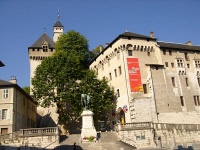
Château des Ducs de Savoie.
|
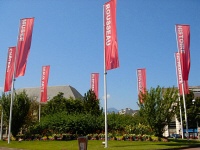
All you need to know about Chambéry.
|
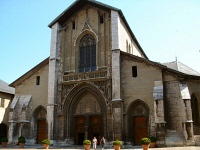
Cathédrale Saint-François.
|
|
| 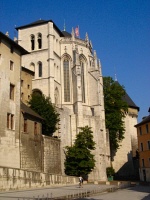
The château's Sainte-Chapelle
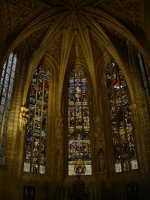
Stained glass in the chapel.
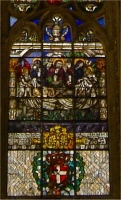
Christ and the Holy Shroud.
|
Nestled between the Bauges and Chartreuse
mountains and only a stones throw away from Lac du Bourget
is the city of Chambéry, historical capital of the
Savoie. The Romans founded the settlement of Lemincum on
the marshes here as a watering hole along the main roads
from Milan to Vienne and Grenoble to Geneva. Today, the
city has about 60,000 inhabitants and is fairly modern with
some basic industry, the University of Savoie, and numerous
museums of art and culture. The old town, having largely
been rebuilt after a WWII bombing raid, is a unique mixture
of broad sweeping pedestrian zones and narrow medieval alleys.
The real jewel of the city is the
château which became the main residence of
Savoie royalty in the 13th century as well as housing the
Savoie senate. The castle was damaged by fire and rebuilt
on numerous occasions, but saw a fair share of residents
from the Savoyard counts to Napoleon III to a Don Felipe
when Chambéry was briefly under Spanish occupation
in the 18th century. In 1502, the Duchess of Savoie had
a special chapel built into the castle to house her most
prized possession – the Holy Shroud. As with the capital,
the Shroud was eventually moved to Turin for reasons of
security.
Aside from the château,
Chambéry's most notable monument is the statue built
for native son General Benoit de Boigne to commemorate his
exploits in India. The sculpture displays the heads of four
elephants and has some very ornate bronze work from the
Grenoble-born sculptor. Sadly, it has nothing to do with
Hannibal as I had hoped. The Carthaginian general is believed
to have taken the less scenic southern route across the
Alps, which makes sense considering his mode of transportation.
One last claim to fame is that Chambéry
was the home of celebrated French (though he was born in
Geneva) philosopher Jean-Jacques Rousseau for almost a decade
when he was a young man. He reputedly did pretty well with
the ladies as he taught music to many of the young socialites
of the day. His first mistress, Mme de Warens, lived and
eventually died in Chambéry. Rousseau is well-known
for his theory that man is ultimately noble at the most
basic level and that society corrupts him. His political
works preached the role of the masses in sovereignty and
are considered by some to have been the roots of communism
and socialism. The statue commemorating the influence Chambéry
had on Rousseau was ironically melted down by the Nazis
for weapons. |
|
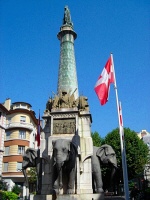
Fontaine des Elephants
|
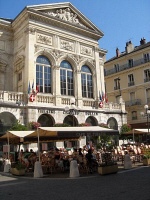
Café outside the theater.
|
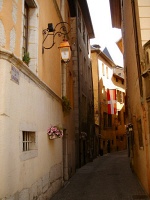
An alley in the old town.
|
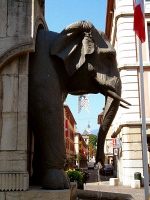
A view toward the château.
|
|
|
|
After
a week in a room that was only marginally larger than the
bed it contained, I decided to get serious. It was time
to find a more permanent place to stay. Prior to my last
trip to France, I had done a fair amount of homework and
found a number of bed and breakfast style chambres d’hôtes.
It paid off brilliantly because I found a more than adequate
room run by a nice couple in a picturesque Provençal
village. Following the same routine for this trip, I had
a few candidates in hand when I journeyed forth to find
myself some digs.
My top choice was a room in Challes-les-Eaux,
a small fabulous town rife with flowers and slightly off
the beaten path yet still within reasonable driving distance
to work. The town got its name from the Challes family who settled
there from Bresse in the 14th century and built a château
near the thermal springs (hence the Eaux part for
"waters"). It now has a full-fledged thermal spa and casino,
but doesn't see nearly the number of tourists that the nearby
spa towns do.
The object of my affection was a
modestly sized room with a private entrance and a swimming
pool on site. The price was a little high but I had some
leverage seeing that I was going to be staying for 11 months.
After some awkward discussion with the propriétaire,
I learned that the owners don't live there year-round and
that the room is really only available for the summer months.
Disappointed but undeterred, I ran down my list of candidates
but met with similar success – either I didn't like the
room or the town or the price. Eventually, I returned to
my closet with a bed to regroup.
|
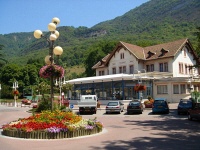
The thermal baths.
|
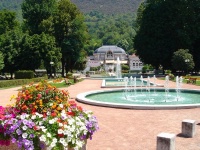
The casino at Challes.
|
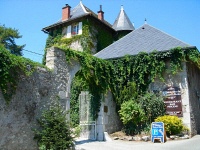
The château at Challes. Now a hotel.
|
|
|
|
I was rapidly running out of
options but got a tip that there was a sort of extended-stay
hotel in a town to the north called Aix-les-Bains.
Always the gracious host, my friend offered to come
along, and we headed up to take a look. It was not
an ideal situation, I was hoping for something more
rural and owned by a family so I could interact with
the natives a little more. The place in question was
located smack in the middle of town and had all the
charm of living in a hotel. Nevertheless, the rooms
were large with a balcony, underground parking (convenient
once winter comes), and a kitchenette. I suffered
during my last stay without the ability to cook or
even a refrigerator, so the kitchenette was very appealing.
With the company discount, the price was right so
I signed on the dotted line.
I moved in the following weekend
and was finally able to unpack. After a few days,
I knew I had made a good decision. Laundry facilities
are onsite, and I have access (for a fee) to the pool,
sauna, and fitness center in the adjoining hotel.
There are also several large grocery stores in the
vicinity and numerous bars in walking distance.
|
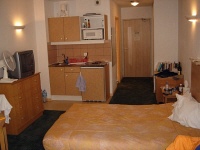
My room with kitchenette.
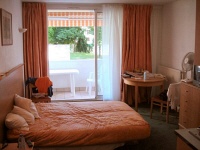
View out to the balcony.
|
|
|
|
